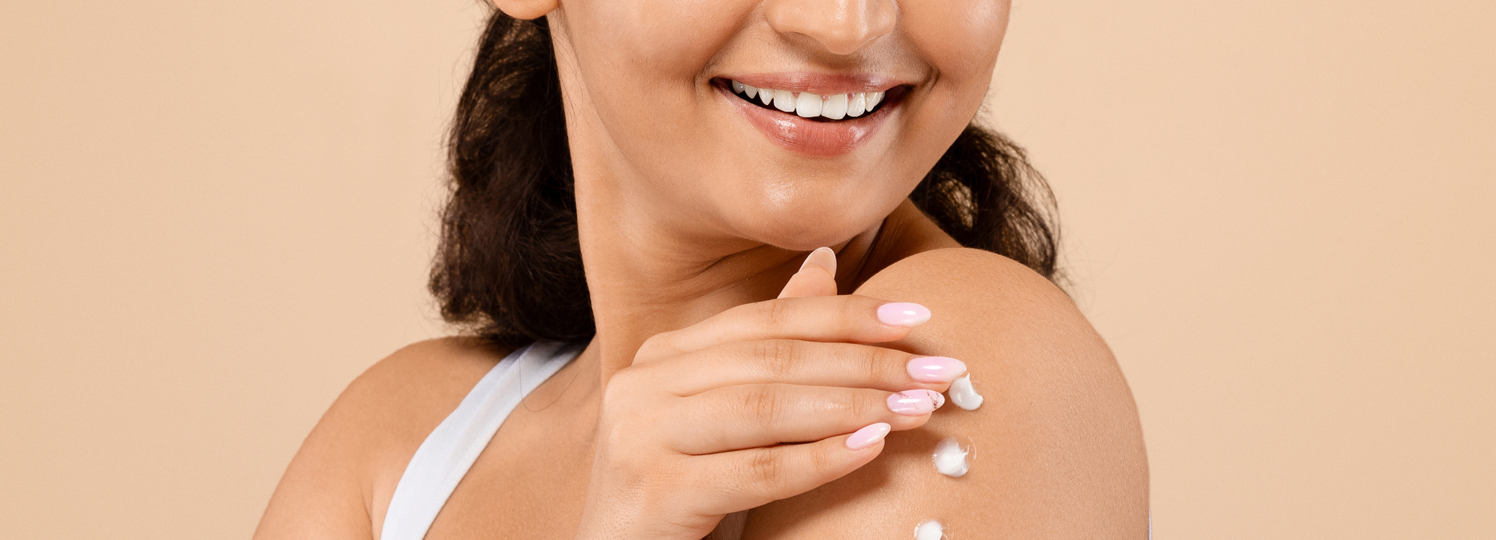

Body Care


Body Care
Body Lotion with rose oil. Like all products from Dr. Baumann SkinIdent, they are free of parabens and all other preservatives, provide a shelf life of more than 30 months, contain high-quality plant-based active ingredients and are free of mineral oils and animal-derived components – vegan and animal-friendly.
200 ml Bottle
Art.-Nr. 3050
Aqua, Butyrospermum Parkii Butter, Simmondsia Chinensis Oil, Butylene Glycol, Urea, Alcohol, D-alpha Tocopheryl Acetate, D-mixed-Tocopherols, Sodium Ascorbyl Phosphate, Sodium Lactate, Lactic Acid, Panthenol, Rosa Damascena Extract (Nat.id.), Xanthan Gum, Cetearyl Glucoside, Sucrose Stearate, Sodium Hydroxide, Citronellol, Geraniol, Linalool
Aqua:
Water. It accounts for around 65% of the weight of the human body and is therefore of fundamental importance for bodily functions, including those of the skin. In many cosmetic products (aqueous solutions, cleansers, emulsions), water is the ingredient with the largest proportion of the formulation in terms of quantity and forms the basis of the aqueous phase in emulsions. Water is a good solvent for polar (hydrophilic) substances such as alcohols, water-soluble vitamins or salts. For use in cosmetic products, the water used is generally pre-treated to remove microorganisms that could lead to spoilage of the product or dissolved salts that may impair the stability of emulsions or gels (sterilization and desalination).
Butyrospermum Parkii Butter:
Shea butter: fat from the seeds of the Butyrospermum Parkii plant. It is particularly suitable for the care of dry and sun-damaged skin. The skin becomes softer and protection against dehydration and UV radiation is built up.
Simmondsia Chinensis Oil:
Some kind of oil
Butylene Glycol:
Solvent with moisturizing effect on the skin, very good compatibility, should be preferred to propylene glycol in products used daily
Urea:
The water-soluble urea is used in numerous cosmetic products. Urea is a component of the natural moisturising factors of the horny layer (content between 7 % and 12 %; up to half lower in chronically dry skin) and has a high water-binding capacity. It contributes to sustained moisturisation of the skin and reduces transepidermal water loss. Urea has a keratoplastic effect, in higher concentrations it has a keratolytic effect and is therefore also used in the care of skin affected by psoriasis or atopic dermatitis (neurodermatitis). Urea is also able to reduce the irritating potential of surfactants.
Alcohol:
Ethyl alcohol: Body identical. Has a refreshing and antibacterial effect. Also serves as a solvent for other ingredients. Contrary to claims to the contrary, there is no risk of a drying effect on the skin at normal application concentrations!
D-alpha Tocopheryl Acetate:
Natural vitamin E acetate; storage form in the skin, is converted into the active form by dissolving the acetate bond; antioxidant with skin-protecting properties, e.g. against UV radiation, retains moisture, delays premature skin ageing
D-mixed-Tocopherols:
Is the name of a mixture of natural tocopherols (vitamin E; D-alpha-, beta-, gamma- and delta-tocopherol). Vitamin E is the most important skin protection vitamin, which protects the skin from UV rays and oxygen radicals.
Sodium Ascorbyl Phosphate:
Highly effective antioxidant and vitamin C donor for the skin
Storage form of vitamin C as a phosphate ester. Water-soluble vitamin with antioxidant properties. It acts against cell-damaging free radicals, protects unsaturated fatty acids from oxidation, is essential for the formation of collagen and thus the entire connective tissue as well as for the function of the immune system. Together with vitamin E, it is very suitable for preventing the formation of nitrosamines.
Sodium Lactate:
Sodium salt of lactic acid: Has a moisturising effect on the skin, with the physiological pH value of the skin averaging 5.5. Important component of the natural moisturising factor (NMF) and the acid mantle of the skin.
Lactic Acid:
Lactic acid. Occurs as a metabolic product in the body and on the skin, has a peeling effect on the horny layer in higher concentrations and at a low pH value of 2 to 3, supports the moisture content in buffered form (physiological pH value of the skin approx. 5.5) and preserves the skin's protective acid mantle.
Panthenol:
D-panthenol = provitamin B5: Improves and increases the skin's ability to retain moisture, has an anti-inflammatory effect, reduces or inhibits itching. Stimulation of epithelialization: Small wounds (shaving), skin abrasions, blisters heal better. When used in hair care products, it is not only deposited on the hair and scalp, it also penetrates them and has a long-term effect. As pantothenic acid is an important component of healthy hair, the precursor D-panthenol serves as “food for the hair” according to scientific studies. It provides the hair with long-lasting moisture, improves the combability of the hair, reduces the formation of split ends, improves the condition of damaged hair, thickens the hair and gives it shine. The brittleness of fingernails is reduced.
Rosa Damascena Extract (Nat.id.):
Rose oil, essential oil with a relaxing and revitalising effect
Xanthan Gum:
Polysaccharide, natural gelling agent with very good skin-compatible properties, is obtained biotechnologically.
Cetearyl Glucoside:
Plant-based emulsifier, composed of body-identical fatty alcohols and body-identical glucose molecules.
Sucrose Stearate:
O/W emulsifier obtained from cane sugar and fat, very skin-friendly, moisturising.
Sodium Hydroxide:
Sodium hydroxide. Used to adjust the pH value of cosmetic products. Sodium and hydroxide ions are identical to the body.
Citronellol:
Fragrance, natural component of essential oils.
Geraniol:
Fragrance, natural component of essential oils. Repels mosquitoes (repellent).
Linalool:
Fragrance, natural component of essential oils.